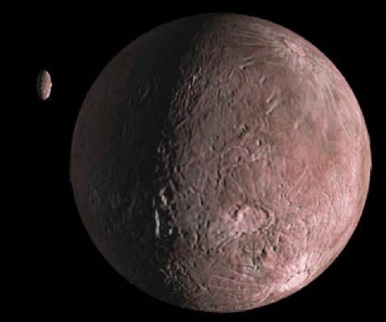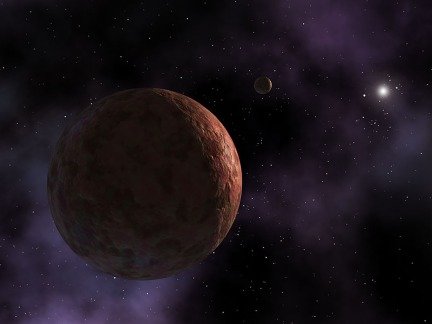Way out past Neptune lies the Kuiper Belt. The most famous and one of the largest Kuiper Belt objects is Pluto, but there are many other interesting objects that hang out around the Kuiper Belt. Another object out in the Kuiper Belt is called Quaoar which is about half the size of Pluto. New Horizons recently took distant pictures of Quaoar as it flies towards its next target MU69 in the distant Solar System. At the time it was discovered in 2002, Quaoar was the next largest object in the Kuiper Belt after Pluto, but was soon surpassed by Eris and others.

While Quaoar is a typical Kuiper Belt object, there are other objects that are not part of the Kuiper Belt, but are also much closer than the Oort Cloud should be. One of these objects is Sedna.
 Sedna is about ¾ the size of Pluto and takes 10,500 years to orbit the Sun. It is located beyond the Kuiper Belt, but is much closer than the Oort Cloud was theorized to be. Sedna is interesting because it is located in no-man’s land on an extremely elliptical orbit. It also is interesting because it seems to have a moon, but no moon is visible from Satellite images. Sedna orbits very far from the inner planets, but also extremely far from the Oort Cloud, so there is not a real explanation for how it ended up in this elliptical orbit. It was probably nudged by distant stars and other objects over and over again until it ended up in its current elliptical orbit. In 2014, another object, VP113, was discovered near Sedna, on a similar orbital path. These types of objects are thought to be part of a different group of objects that is beyond the Kuiper Belt, but still far away from the Oort Cloud.
Sedna is about ¾ the size of Pluto and takes 10,500 years to orbit the Sun. It is located beyond the Kuiper Belt, but is much closer than the Oort Cloud was theorized to be. Sedna is interesting because it is located in no-man’s land on an extremely elliptical orbit. It also is interesting because it seems to have a moon, but no moon is visible from Satellite images. Sedna orbits very far from the inner planets, but also extremely far from the Oort Cloud, so there is not a real explanation for how it ended up in this elliptical orbit. It was probably nudged by distant stars and other objects over and over again until it ended up in its current elliptical orbit. In 2014, another object, VP113, was discovered near Sedna, on a similar orbital path. These types of objects are thought to be part of a different group of objects that is beyond the Kuiper Belt, but still far away from the Oort Cloud.

The Kuiper Belt is an area that holds much intrigue for me, especially with the recent discoveries that are occurring in the area and Pluto, our beloved demoted planet, orbiting out there. Do you think Sedna could be a former planet gone rogue? Or will it ever receive a classification of dwarf planet? How do they know that there is a moon if there are no images?
LikeLike
From what I’ve read, Sedna was a part of the first generation of Oort Cloud objects so was before the Sun was fully formed and originally was in more of a circular orbit, but kind of went rogue as it got pushed little by little from passing stars and has slowly ended up in its extremely elliptical orbit. It isn’t officially recognized as a dwarf planet, but if you look up information about it, it is called a dwarf planet. And they think there is a moon because every 20 days, it gets a little bit darker and then lightens again. This is probably because there are light and dark spots on the surface, but 20 days is longer than they expect it to spin. They think this is because it has a moon that has slowed its spin, similar to how Charon slowed Pluto, but there is not an image that shows the moon. There are several possible reasons for this.
LikeLike
It’s kind of impossible for the Pluto fans to argue that their favorite dwarf planet is a real planet now. We just have so many other Plutos out there in the outer solar system that it would be unfair to the rest. I do wonder though, is it possible we find an object out in the Kuiper Belt that is actually large enough to qualify as a planet? After all, the dwarf planets similarly-sized to Pluto were a relatively recent discovery, so it’s not completely unlikely that a true planet could be discovered hiding amidst an army of dwarves.
LikeLike
Yeah I definitely agree, it is strange to think how there could be a “normal” planet hiding within the dwarf planets that we are just now discovering. I’ve always found it kind of hard to believe there could be a large planet out there because it seems like we have always known about the classical planets. However, I’ve also always thought it was exciting that we can still discover so much about our Solar System.
LikeLike
I read a similar article further documenting New Horizons’ path towards its next target, 2014 MU69, and noticed an almost equal interest in the composition of the space between the Kuiper Belt objects as there is in the objects themselves, noting a charged particle and dust environment that stretches throughout the entire Kuiper Belt.
What is interesting is that this cloud of particulates might be the remnants still of the creation of the Solar System, and has the very exciting opportunity to potentially open up insight on the creation of the Solar System
It will be neat to see what information and conclusions can be drawn from this further exploration
LikeLike